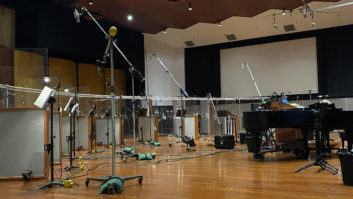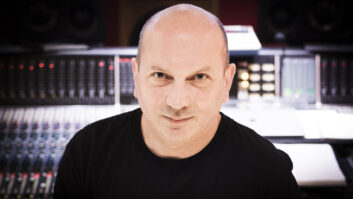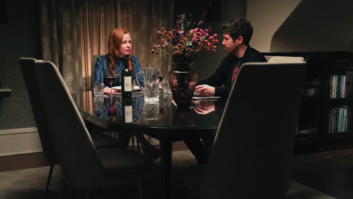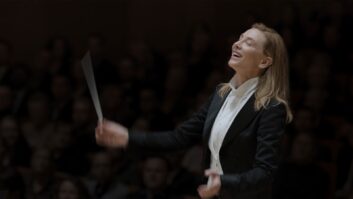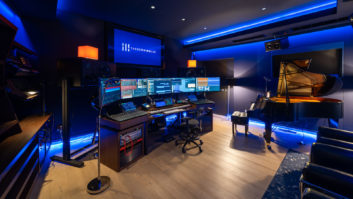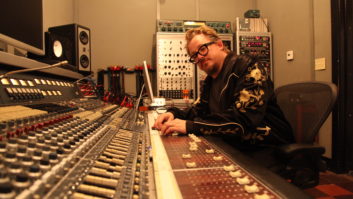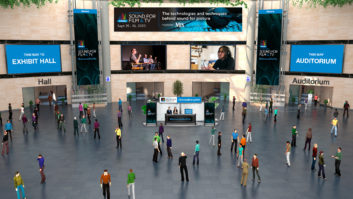Scoring Mixers Talk Monitoring
Robert “Bobby” Fernandez with PMC MB2S reference
monitors Last month, composer Henry Jackman and Geoff Zanelli spoke of their processes and the importance of accurate monitoring. This month, we take that to the next stage of production with recording, scoring and remix engineers Tommy Vicari, Robert Fernandez and James Hill.

For the past several years, scoring engineer Tommy Vicari has worked almost exclusively with leading composer Thomas Newman on a variety of film scores. “We first worked together on the TV series, Six Feet Under,” the engineer remembers. “I next handled the score for The Road to Perdition.” Since then, the pair have worked together on such films as Brothers, Revolutionary Road, WALL·E, Towelhead, The Good German, Little Children, Jarhead, Cinderella Man, Lemony Snicket’s A Series of Unfortunate Events and Finding Nemo, plus the TV mini-series, Angels in America. Recently completed projects include the scores for The Debt, directed by John Madden, and The Adjustment Bureau, written and directed by George Nolfi.
“I chose to use the same brand of monitors that Thomas had installed at his home composing room,” Vicari recalls, “and have never used anything since. I look for a clean, linear, full-range response that can accommodate the most complex of orchestral cues plus the synthesizer elements, ambient noises and percussion sounds that are often added as effects. A movie score is a complex entity, with widely varying components, so I need reference monitors that can accommodate a broad range of signals.”
Like many scoring engineers, Vicari takes a set of transportable monitor loudspeakers to the scoring stage to ensure full compatibility between the spaces in which the music will be relayed. “Otherwise,” he confides, “I might miss a subtle sound in the score, or be unable to hear how the various pre-recorded elements and the orchestral score—if that is the direction in which Thomas has decided to go—are working with one another. I first heard the MB2S-XBD and MB2S-C monitors at The Village [in West Los Angeles] and was astounded at how clean and beautiful they sounded. I was really amazed at the difference good monitors can make to a mix. They were very neutral, with no hype and no coloration at the top end; they do not flatter the mix but reveal everything I need to hear. To be honest, I’m upset that I hadn’t done it before!” Newman and Vicari turn to seasoned scoring mixer Armin Steiner to record the composer’s orchestral sessions; tracks are remixed at Paramount Studios, The Village or Signet Sound Studios. “I first used these new monitors to mix Thomas’ music for The Debt. The clarity of the score was outstanding.”
Above: James Hill with IB2S reference monitors.
Right: Tommy Vicari with PMC MB2S-XBD for
left/right and MB2S-C for center Having worked at Warner Bros’ Eastwood Scoring Stage in Burbank for 16 years, Robert “Bobby” Fernandez is now a first-call independent scoring and remix engineer; he also operates Secret Studio, a project facility used to remix his various TV and film-music projects. Fernandez also has access to a transportable system that he takes to scoring sessions. “I use the same brand of reference monitor loudspeakers for my near- and far-field reference systems here at Secret Studio,” Fernandez confides, “and my even more powerful system mounted in custom road cases for the scoring stage, which normally features a larger control room.”

In recent years, Fernandez has worked on the majority of director Clint Eastwood’s motion pictures, culminating with Gran Tornino, Invictus and Hereafter; other scoring projects include The Expendables, The Wolfman, The Day the Earth Stood Still, Role Models, The Mummy: Tomb of the Dragon Emperor, Kit Kittredge: An American Girl, Changeling and Spider-Man 3. He has also mixed the music for a number of successful TV series, including John Adams and Battlestar Galactica, and has garnered several Grammy Awards, including one for his work on Ray Charles’ Genius Loves Company CD. Recent scores include Battle: Los Angeles and A Thousand Words.
“Accurate sound translation between monitor loudspeakers is the key to the way I work,” the mixer stresses. “I remember while working on the soundtrack CD for Invictus, we took the mixes [to a mastering house in Hollywood] that was equipped with the same three-way monitors I use at Secret Studio. I got a call from the mastering engineer, asking me what speakers I’d used to mix the tracks. He responded that he’d guessed that we both used the same reference systems, because the tracks played back so well and translated beautifully. And my pair of playback systems [at Secret Studio] has the exact same tonality and a balanced frequency range. They are very faithful at capturing every nuance of my mixes. I need that consistent, accurate sound.”
“Because I like to mix at reasonable sound levels,” the engineer continues, “I prefer my smaller, up-close monitors that let me work for long hours. I can then put up the stereo or surround mix on my bigger, three-way systems. The mix always sounds exactly the same, just louder, slightly more present and with a little more ‘body.’ The compatibility between these two monitoring arrays and my larger, transportable rig is truly remarkable.”
Recording/remix engineer James Hill opted for a portable reference system that can be used both within his downtown Los Angeles loft studio and on Hollywood scoring stages. “Film composer James Newton Howard was using these models,” Hill recalls, “and so I opted for a left/center/ right array. I soon discovered that they were easy to work on for long periods of time, and very smoothsounding, an essential requirement for high-precision monitors that let me hear every nuance of a score.”

Hill worked with Newton Howard for eight years before going freelance four years ago. In additional to handling the scores for such films as The Chosen One, New Beginnings, TheWork of Angels, Witchcraft, Legacy, The Four- Faced Liar, Charlie St. Cloud and Collateral, Hill has worked on a number of successful TV series, including The Tudors, No OrdinaryFamily and AMC Television’s successful cable series, Mad Men. Recent scoring projects include Highland Park, A Good Old Fashioned Orgy and Love, Wedding, Marriage.
“We recorded Jeff Rona’s score for The Chosen One at the Eastwood Stage with a 50-piece orchestra, plus synthesizer elements and pan pipes, after tracking guitar, percussion and other instruments at The Village, and mixed at my studio. The score for Charlie St. Cloud, composed by Rol fe Kent , was recorded at Fox Scoring and mixed in three days here. Given so many different environments, I need to rely on the accuracy of my reference monitor s to ensur e that I record component tracks that will blend together within the final soundtrack. Working in Pro Tools, like most of my scoring colleagues, I generate a number of 5.1-channel orchestral stems, 5.0-channel piano and harp, and so on; normally, I will deliver a total of 40 tracks, including pre-recorded elements.”
For portability, Hill selected a relatively compact set of reference monitors for his LCR array. “Despite their size,” Hill states, “the system works very well at high volume and can be pushed hard without distorting. The bottom-end, in particular, is very powerful; it’s a very easy configuration on which to mix. It is equally important that they produce a transparent sound, even at low volumes, with outstanding imaging. I find that I can work for long periods of time without ear fatigue, a major consideration while working on complex mixes that comprise orchestral and synthesizer tracks. Because they are very accurate, I’m able to hear things faster than on my previous systems, which means that I can make critical decisions much quicker.”

